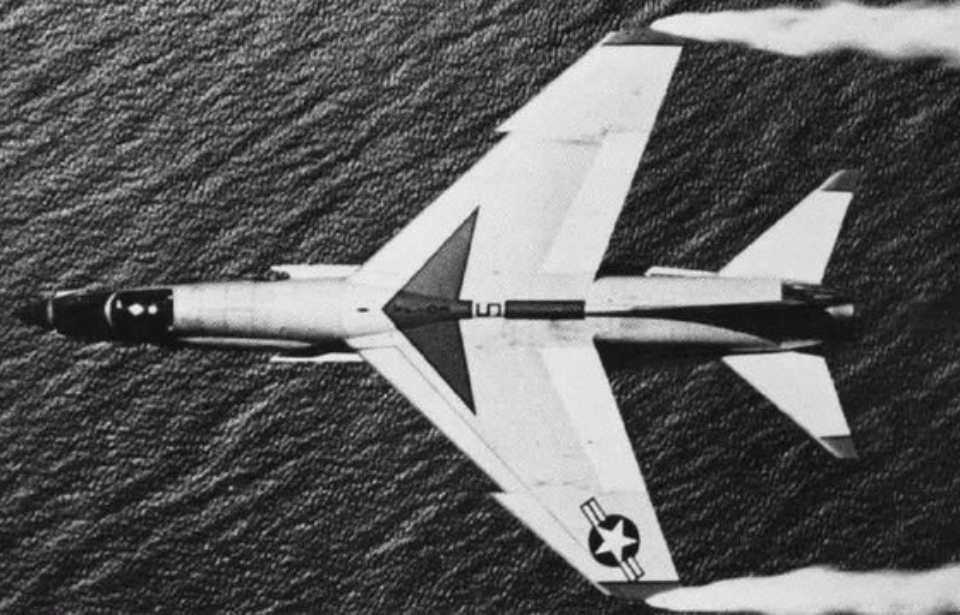The Vought F-8 Crusader was an American jet-powered fighter that served with the US Navy from 1957-76. During its tenure, the aircraft participated in the Cuban Missile Crisis, as well as the Vietnam War. As the last American-made fighter to have guns as its primary armament, it was nicknamed the “Last of the Gunfighters.”
Development of the Vought F-8 Crusader
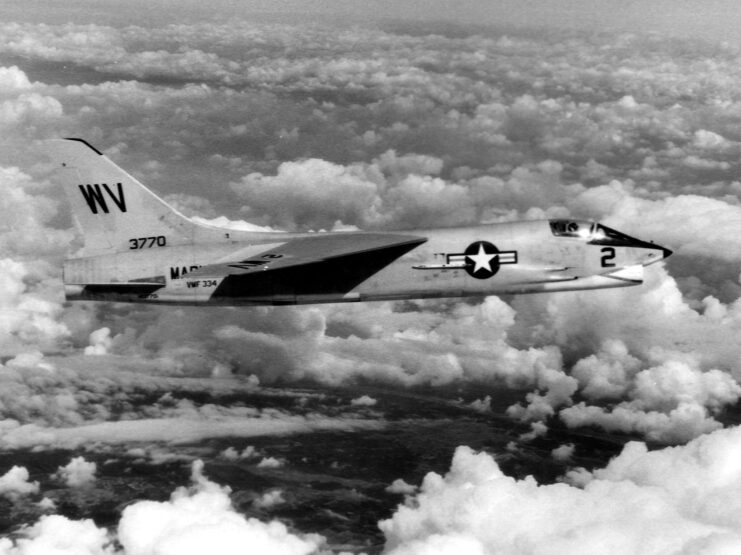
In September 1952, the Navy announced it was looking for a new fighter. It needed a maximum speed of Mach 1.2, a climb rate of 25,000 feet per minute and a maximum landing speed of 100 MPH. The decision was also made to arm the aircraft with 20 mm cannons, due to the inadequacies of .50-caliber machine guns during the Korean War.
Competitors for the contract included the Grumman F-11 Tiger, the McDonnell F3H Demon and the carrier version of the North American F-100 Super Sabre. Vought’s F-8 Crusader was deemed the winner in May 1953, with the Navy ordering three prototypes.
The first F-8 prototype, designated the XF8U-1, flew on March 25, 1955 and exceeded the speed of sound. Seeing no issues with the aircraft, the second prototype flew a few months later, on September 30. In 1956, the F-8 began weapons and carrier tests, with its first successful catapult launch occurring on April 4. A few months later, on August 21, the aircraft set a new US national speed record, reaching 1,015.428 MPH.
In December 1956, Air Development Squadron 3 (VX-3) completed the F-8’s qualifications onboard carriers. Deemed ready for service, the first aircraft joined Fighter Squadron 32 (VF-32), Fighter Squadron 154 (VF-154) and Marine Fighter Squadron 122 (VMF-122) in 1957.
Vought F-8 Crusader specs
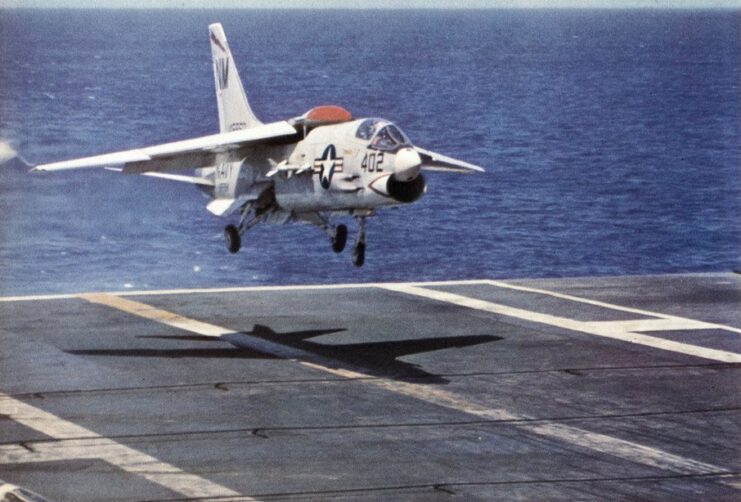
The F-8 Crusader had a distinctive look, with a central air intake under a pointed nose, high-mounted wings and a short landing gear giving it an overall crouched appearance. Unique to the aircraft was its variable-incidence wing. This meant the whole wing could be pitched up to a maximum of seven degrees, allowing for takeoff or landing at slower speeds, without pilots losing any visibility. This design also allowed lift to be maintained and increased by lowering the aircraft’s flaps and leading-edge.
The F-8 was powered by a single 18,000-pound static thrust with reheat Pratt and Whitney J57-P-20 turbojet. Its use with the F-8 was exceptional, allowing for a maximum speed of 1,227 MPH at 36,000 feet – this made it the first operational aircraft to fly faster than 1,000 MPH.
The primary armaments for the F-8 were four forward-firing 20 mm cannons. These weapons, in an era that saw the introduction and movement toward missiles, gave the aircraft its nickname: the “Last of the Gunfighters.” That being said, the F-8 was also equipped with pylons on either side of the fuselage and under the wings, allowing it to carry either four AIM-9 Sidewinders or up to 5,000 pounds of ordnance.
‘Ensign Eliminator’
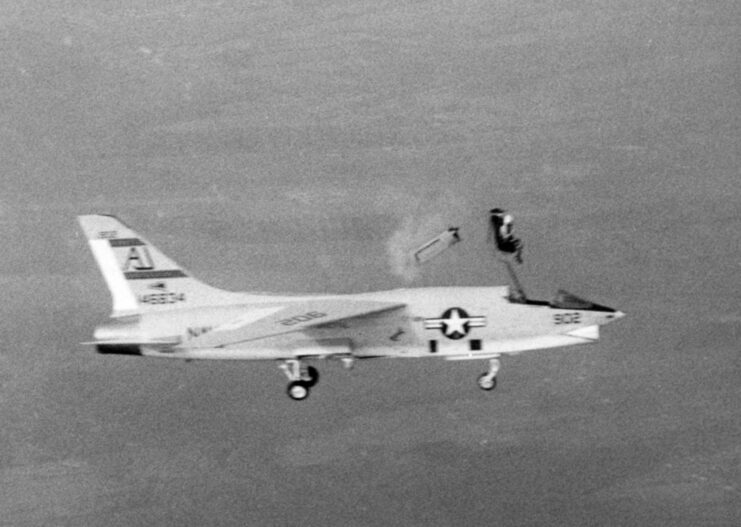
While the Navy had high hopes for the F-8 Crusader, the fighter wasn’t without its issues. This was largely due to its nose design, which made it particularly dangerous for pilots to land aboard aircraft carriers. To accomplish a safe landing, the vessels had to be traveling at full speed, to subsequently lower the relative landing speed of the F-8s, lest they and their pilots wind up in the ocean.
It already wasn’t an easy aircraft to fly, and this led pilots to give the aircraft another nickname: the “Ensign Eliminator.”
Problems also arose as the F-8 continued to see active service, particularly during the Vietnam War. Pilots had to eject a number of times, often resulting in the loss of the aircraft. It’s estimated that, out of the over 1,200 that were built by Vought, around 1,106 were involved in incidents.
Cuban Missile Crisis
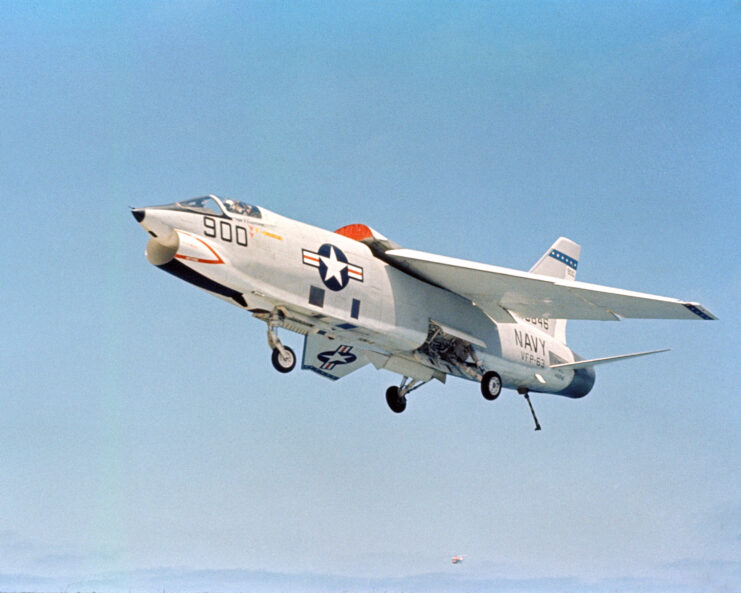
Starting on October 23, 1962, F-8 Crusaders played a pivotal role in the capturing of reconnaissance images during the Cuban Missile Crisis. An unarmed variant, the RF-8A, was equipped with cameras, instead of missiles, and tasked with flying low-level reconnaissance missions over Cuba, to capture photos of Cuban and Soviet forces.
Flying two missions a day, these RF-8As would depart from Florida, fly over Cuba and, upon their return, have their images delivered to the Pentagon for examination. The photos captured by these aircraft confirmed the Soviets had begun efforts to install medium-range ballistic missiles in Cuba.
RF-8As continued to monitor the withdrawal of Soviet forces and missiles from the region. At the conclusion of the Cuban Missile Crisis, they’d captured a total of 160,000 images.
Vietnam War
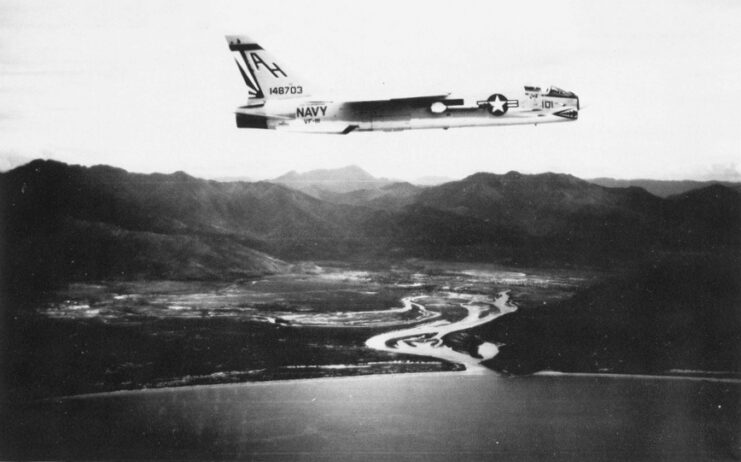
The Vietnam War saw the F-8 Crusader gain its first combat experience.
When the conflict started, the aircraft stationed aboard the USS Hancock (CV-19) became the first from the US to enter into air-to-air combat with North Vietnamese-flown Mikoyan-Gurevich MiG-17s. The incident occurred on April 3, 1965, and saw the F-8s score no kills. Despite one being hit by enemy fire, all safely returned to Hancock.
The first F-8 success came in June 1966. After getting into a dogfight with a MiG-17, Cmdr. Harold L. Marr fired two Sidewinders. The first missed, but the second hit the MiG’s tail, blowing off it and the starboard wing.
By the end of the war, F-8s had claimed between 18-19 air-to-air kills (depending on the source), the majority of which were achieved with Sidewinder missiles. Only four were attributed to the fighters’ guns, due to the magazines’ propensity to jam during high-speed dogfights.
The aircraft enjoyed the greatest kill ratio of all US fighters during the conflict, only suffering three losses in combat. Others, in greater numbers, were lost to flak, surface-to-air missiles (SAMs) and operational accidents. This meant the total number lost in Vietnam hit between 166-170.
Vought F-8 Crusader’s service with the French Navy
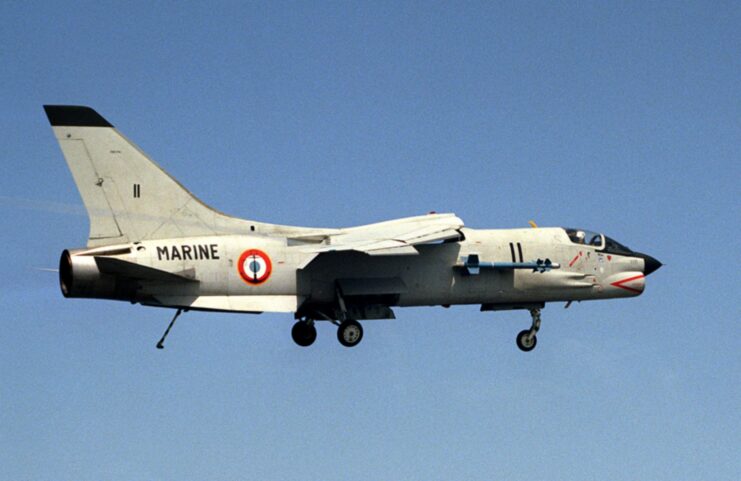
The F-8 Crusader entered service with the French Navy in 1964 and quickly became the backbone of the country’s naval air power, serving aboard two aircraft carriers, Clemenceau and Foch.
French F-8E(FN)s saw service over Lebanon in 1983. Between 1991-94, they were rebuilt, extending their service life until the end of the decade. Despite its continued service, the F-8 didn’t join the French forces fighting in the Gulf War, nor during the Kosovo Air Campaign.
More from us: The Republic F-84 Thunderjet Was the ‘Champ of the Fighter-Bombers’
In December 1999, the French retired their remaining fleet of F-8s, replacing the aircraft with the Dassault Rafale M the following year.
